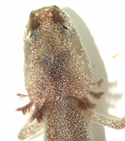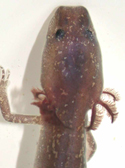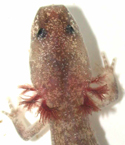The captive breeding program is a requirement of the City’s federal 10a1B permit which authorizes “incidental take” for the operation of Barton Springs Pool (which contains endangered species habitat) as a public swimming facility.
Purpose
The City of Austin established the captive breeding program for the Barton Springs Salamander as a safeguard in case of extinction in the wild in case a catastrophic event destroying its habitat. However, maintaining a captive population is not a replacement for protecting their natural habitat, which must be preserved over the long-term. If the wild population were to die off, the cause would need to be identified and remedied before animals in the captive breeding program were released into the wild.
In addition to acting as a “backup” for the wild population, the captive breeding program has also provided the opportunity to learn more about the salamanders.
Measure 41 of the City’s federal permit states: “The City of Austin will maintain a viable captive breeding population of Barton Springs Salamanders. The City will designate a staff biologist and dedicate a minimum of $20,000 annually to the development and maintenance of this program. The purpose of the program is to provide a contingency plan for the species if a catastrophic event were to occur.”
History
The program began in 1998 in a cubicle of a downtown Austin office building. Since then, the program has been moved to two other locations (including the University of Texas at Austin) before settling into a permanent facility at the Austin Nature and Science Center in 2008. Each new location provided more space to expand with additional breeding tanks and offspring.
Science
The Barton Springs Salamander can be difficult to study since it spends part of its life in the aquifer. The captive breeding program plays an important role in increasing the scientific knowledge of the Barton Springs and Austin Blind salamanders.
Through early work in developing the program, staff discovered a new species – the Austin Blind Salamander (Eurycea waterlooensis). This species is also in the captive breeding program. However, because it spends most of its life in the aquifer, few individuals are found at the springs.
Tracking Individuals
Salamanders are tracked as individuals by taking photographs of the dorsal view of the head. Head patterns are distinct; while they do change over time, photographing the salamanders every couple of years allows the researchers to keep up with the changes.
Notice the three different individuals pictured below. A photograph of the head can be used to pick the individual out of a group of tank mates.



There have been 148 Barton Springs Salamander egg-laying events during the course of the program. The average number of eggs laid in a clutch in captivity is 15. About 20% of those eggs survive to six months of age. There have been nine Austin Blind Salamander egg-laying events during the course of the program with an average of 14 eggs per clutch.
Barton Springs Salamanders are not sexually dimorphic. However, the skin on the ventral side of the body is translucent, allowing researchers to identify individuals as male or female by the presence/absence of eggs or testes.
If possible, the female laying a clutch of eggs is identified so that the offspring can be tracked as offspring of that particular female. It is impossible to determine the sire, however, if more than one male has been in the tank with the female. Genetic analysis is the only way to determine the sire if there are multiple possible males. Information on parents and possible parents is tracked in order to evaluate the genetics of the captive-raised population.
